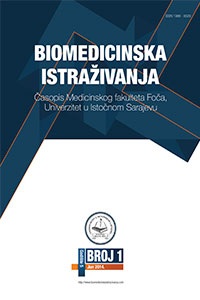Vitamin D and atherosclerosis
DOI:
https://doi.org/10.5937/BII2101099LAbstract
Cardiovascular diseases rank first on the mortality list globally
or 31%. The basic measure of prevention in accordance with
the recommendations of the World Health Organization is a
change in risk lifestyle in terms of diet, physical activity, tobacco
and alcohol consumption. Vitamin D was previously recognized
as a regulator of calcium and phosphorus ratio, bone
remodeling or the main controller of skeletal pathophysiology.
However, vitamin D enjoys great interest in clinical and
epidemiological research in terms of its possible impact on
reducing the risk of cardiovascular diseases. Among other
things, vitamin D deficiency is associated with an increased
risk of endothelial dysfunction. Although the deficiency has
been identified as a risk marker for cardiovascular diseases,
the mechanism of action of vitamin D on the path from endothelial
dysfunction to cardiovascular diseases has not been
fully revealed. The findings in this segment of activity of vitamin
D would be significant in terms of reducing morbidity
and mortality from cardiovascular diseases.

